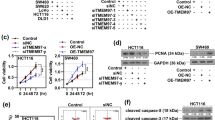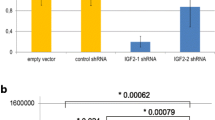Abstract
Recent evidence suggests that HER2 (ErbB2; Her-2/neu) and the related PI3K/Akt signaling pathway substantially affect the malignant phenotype of colorectal cancer cells. Moreover, fatty acid synthase (FASN), which mediates de-novo fatty acid synthesis, is crucially important in the carcinogenesis process of a variety of cancers, including colorectal cancer. The purpose of this study was to investigate the malignant phenotype regulation of colorectal cancer cells via the “HER2–PI3K/Akt–FASN axis”. Caco-2 cells with high expression of HER2 and FASN and high transfection efficiency were selected for functional characterization. The cells were transfected with either HER2-specific RNAi plasmid or negative control RNAi plasmid, followed by Q-RT-PCR and western blot assays to examine expression of HER2, PI3K, Akt, and FASN. MTT and colony-formation assays were used to assess proliferation. Migration was investigated by use of the transwell assay, and apoptosis and cell cycle were assayed by use of flow cytometry. Expression of HER2, PI3K, Akt, and FASN were downregulated when HER2 was silenced. Proliferation decreased after downregulation of HER2, which was consistent with increased apoptosis. Migration of HER2-silenced cells was also impaired. Loss of HER2 inhibits the activity of the “HER2–PI3K/Akt–FASN axis” of Caco-2 cells, and reduced activity of this axis alters the malignant behavior of Caco-2 cells.






Similar content being viewed by others
Abbreviations
- FASN:
-
Fatty acid synthase
- Q-RT-PCR:
-
Quantitative real-time polymerase chain reaction
- MTT:
-
3-(4,5-Dimethylthiazol-2-yl)-2,5-diphenyltetrazolium bromide
- RNAi:
-
RNA interference
References
Jemal A, Siegel R, Ward E, Hao Y, Xu J, Murray T, Thun MJ (2008) Cancer statistics. CA Cancer J Clin 58(2):71–96
Yarden Y, Sliwkowski MX (2001) Untangling the ErbB signaling network. Natl Rev Mol Cell Biol 2(2):127–137
Davidson NE (2011) HER2-targeted therapies: how far we’ve come—and where we’ve headed. Oncology (Williston Park) 25(5):425–426
Ménard S, Pupa SM, Campiglio M, Tagliabue E (2003) Biologic and therapeutic role of HER2 in cancer. Oncogene 22(42):6570–6578
Corsi F, Fiandra L, De Palma C, Colombo M, Mazzucchelli S, Verderio P, Allevi R, Tosoni A, Nebuloni M, Clementi E, Prosperi D (2011) HER2 expression in breast cancer cells is downregulated upon active targeting by antibody-engineered multifunctional nanoparticles in mice. ACS Nano 5(8):6383–6393
Porebska I, Harlozinska A, Bojarowski T (2000) Expression of the tyrosine kinase activity growth factor receptors (EGFR, ERB B2, ERB B3) in colorectal adenocarcinomas and adenomas. Tumour Biol 21(2):105–115
LaBonte MJ, Wilson PM, Fazzone W, Russell J, Louie SG, El-Khoueiry A, Lenz HJ, Ladner RD (2011) The dual EGFR/HER2 inhibitor lapatinib synergistically enhances the antitumor activity of the histone deacetylase inhibitor panobinostat in colorectal cancer models. Cancer Res 71(10):3635–3648
Kuhajda FP (2000) Fatty-acid synthase and human cancer: new perspectives on its role in tumor biology. Nutrition 16(3):202–208
Wakil SJ (1989) Fatty acid synthase, a proficient multifunctional enzyme. Biochemistry 28(11):4523–4530
Maier T, Jenni S, Ban N (2006) Architecture of mammalian fatty acid synthase at 4.5 A resolution. Science 311(5765):1258–1262
Kuhajda FP (2006) Fatty acid synthase and cancer: new application of an old pathway. Cancer Res 66(12):5977–5980
Huang PL, Zhu SN, Lu SL, Dai ZS, Jin YL (2000) Inhibitor of fatty acid synthase induced apoptosis in human colonic cancer cells. World J Gastroenterol 6(2):295–297
Huang CH, Tsai SJ, Wang YJ, Pan MH, Kao JY, Way TD (2009) EGCG inhibits protein synthesis, lipogenesis, and cell cycle progression through activation of AMPK in p53 positive and negative human hepatoma cells. Mol Nutr Food Res 53(9):1156–1165
Kumar-Sinha C, Ignatoski KW, Lippman ME, Ethier SP, Chinnaiyan AM (2003) Transcriptome analysis of HER2 reveals a molecular connection to fatty acid synthesis. Cancer Res 63(1):132–139
Menendez JA, Mehmi I, Verma VA, Teng PK, Lupu R (2004) Pharmacological inhibition of fatty acid synthase (FAS): a novel therapeutic approach for breast cancer chemoprevention through its ability to suppress Her-2/neu (erbB-2) oncogene-induced malignant transformation. Mol Carcinog 41(3):164–178
Livak KJ, Schmittgen TD (2001) Analysis of relative gene expression data using real-time quantitative PCR and the 2(-Delta Delta C(T)) Method. Methods 25(4):402–408
Vazquez-Martin A, Colomer R, Brunet J, Lupu R, Menendez JA (2008) Overexpression of fatty acid synthase gene activates HER1/HER2 tyrosine kinase receptors in human breast epithelial cells. Cell Prolif 41(1):59–85
Migita T, Ruiz S, Fornari A, Fiorentino M, Priolo C, Zadra G, Inazuka F, Grisanzio C, Palescandolo E, Shin E, Fiore C, Xie W, Kung AL, Febbo PG, Subramanian A, Mucci L, Ma J, Signoretti S, Stampfer M, Hahn WC, Finn S, Loda M (2009) Fatty acid synthase: a metabolic enzyme and candidate oncogene in prostate cancer. J Natl Cancer Inst 101(7):519–532
Menendez JA, Lupu R, Colomer R (2005) Targeting fatty acid synthase: potential for therapeutic intervention in her-2/neu-overexpressing breast cancer. Drug News Perspect 18(6):375–385
Chiang CT, Way TD, Tsai SJ, Lin JK (2007) Diosgenin, a naturally occurring steroid, suppresses fatty acid synthase expression in HER2-overexpressing breast cancer cells through modulating Akt, mTOR and JNK phosphorylation. FEBS Lett 581(30):5735–5742
Grunt TW, Wagner R, Grusch M, Berger W, Singer CF, Marian B, Zielinski CC, Lupu R (2009) Interaction between fatty acid synthase- and ErbB-systems in ovarian cancer cells. Biochem Biophys Res Commun 385(3):454–459
Horiguchi A, Asano T, Asano T, Ito K, Sumitomo M, Hayakawa M (2008) Pharmacological inhibitor of fatty acid synthase suppresses growth and invasiveness of renal cancer cells. J Urol 180(2):729–736
Carvalho MA, Zecchin KG, Seguin F, Bastos DC, Agostini M, Rangel AL, Veiga SS, Raposo HF, Oliveira HC, Loda M, Coletta RD, Graner E (2008) Fatty acid synthase inhibition with Orlistat promotes apoptosis and reduces cell growth and lymph node metastasis in a mouse melanoma model. Int J Cancer 123(11):2557–2565
Liu H, Liu Y, Zhang JT (2008) A new mechanism of drug resistance in breast cancer cells: fatty acid synthase overexpression-mediated palmitate overproduction. Mol Cancer Ther 7(2):263–270
Marmor MD, Skaria KB, Yarden Y (2004) Signal transduction and oncogenesis by ErbB/HER receptors. Int J Radiat Oncol Biol Phys 58(3):903–913
Citri A, Yarden Y (2006) EGF–ERBB signalling: towards the systems level. Natl Rev Mol Cell Biol 7(7):505–516
Kandel ES, Hay N (1999) The regulation and activities of the multifunctional serine/threonine kinase Akt/PKB. Exp Cell Res 253(1):210–229
Wang HQ, Altomare DA, Skele KL, Poulikakos PI, Kuhajda FP, Di Cristofano A, Testa JR (2005) Positive feedback regulation between AKT activation and fatty acid synthase expression in ovarian carcinoma cells. Oncogene 24(22):3574–3582
Acknowledgments
This study was supported by the National Natural Science Foundation of China (30973475) and the Natural Science Foundation of Jiangsu Province, China (BK2008305). Lida Zhang, Xiaojin Yu, Xiaoqiang Tian, Yunlang Cai, Qiqiang Long, and Yinghui Lu also contributed to this study.
Conflict of interest
The authors declare there is no conflict of interest.
Author information
Authors and Affiliations
Corresponding author
About this article
Cite this article
Li, N., Bu, X., Wu, P. et al. The “HER2–PI3K/Akt–FASN Axis” Regulated Malignant Phenotype of Colorectal Cancer Cells. Lipids 47, 403–411 (2012). https://doi.org/10.1007/s11745-011-3649-7
Received:
Accepted:
Published:
Issue Date:
DOI: https://doi.org/10.1007/s11745-011-3649-7




